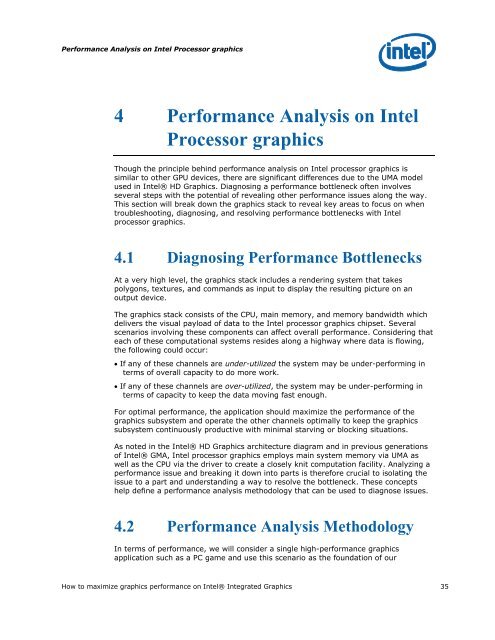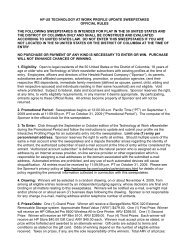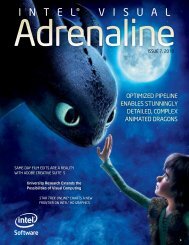Intel HD Graphics DirectX Developer's Guide (Sandy Bridge)
Intel HD Graphics DirectX Developer's Guide (Sandy Bridge)
Intel HD Graphics DirectX Developer's Guide (Sandy Bridge)
You also want an ePaper? Increase the reach of your titles
YUMPU automatically turns print PDFs into web optimized ePapers that Google loves.
Performance Analysis on <strong>Intel</strong> Processor graphics<br />
4 Performance Analysis on <strong>Intel</strong><br />
Processor graphics<br />
Though the principle behind performance analysis on <strong>Intel</strong> processor graphics is<br />
similar to other GPU devices, there are significant differences due to the UMA model<br />
used in <strong>Intel</strong>® <strong>HD</strong> <strong>Graphics</strong>. Diagnosing a performance bottleneck often involves<br />
several steps with the potential of revealing other performance issues along the way.<br />
This section will break down the graphics stack to reveal key areas to focus on when<br />
troubleshooting, diagnosing, and resolving performance bottlenecks with <strong>Intel</strong><br />
processor graphics.<br />
4.1 Diagnosing Performance Bottlenecks<br />
At a very high level, the graphics stack includes a rendering system that takes<br />
polygons, textures, and commands as input to display the resulting picture on an<br />
output device.<br />
The graphics stack consists of the CPU, main memory, and memory bandwidth which<br />
delivers the visual payload of data to the <strong>Intel</strong> processor graphics chipset. Several<br />
scenarios involving these components can affect overall performance. Considering that<br />
each of these computational systems resides along a highway where data is flowing,<br />
the following could occur:<br />
If any of these channels are under-utilized the system may be under-performing in<br />
terms of overall capacity to do more work.<br />
If any of these channels are over-utilized, the system may be under-performing in<br />
terms of capacity to keep the data moving fast enough.<br />
For optimal performance, the application should maximize the performance of the<br />
graphics subsystem and operate the other channels optimally to keep the graphics<br />
subsystem continuously productive with minimal starving or blocking situations.<br />
As noted in the <strong>Intel</strong>® <strong>HD</strong> <strong>Graphics</strong> architecture diagram and in previous generations<br />
of <strong>Intel</strong>® GMA, <strong>Intel</strong> processor graphics employs main system memory via UMA as<br />
well as the CPU via the driver to create a closely knit computation facility. Analyzing a<br />
performance issue and breaking it down into parts is therefore crucial to isolating the<br />
issue to a part and understanding a way to resolve the bottleneck. These concepts<br />
help define a performance analysis methodology that can be used to diagnose issues.<br />
4.2 Performance Analysis Methodology<br />
In terms of performance, we will consider a single high-performance graphics<br />
application such as a PC game and use this scenario as the foundation of our<br />
How to maximize graphics performance on <strong>Intel</strong>® Integrated <strong>Graphics</strong> 35













